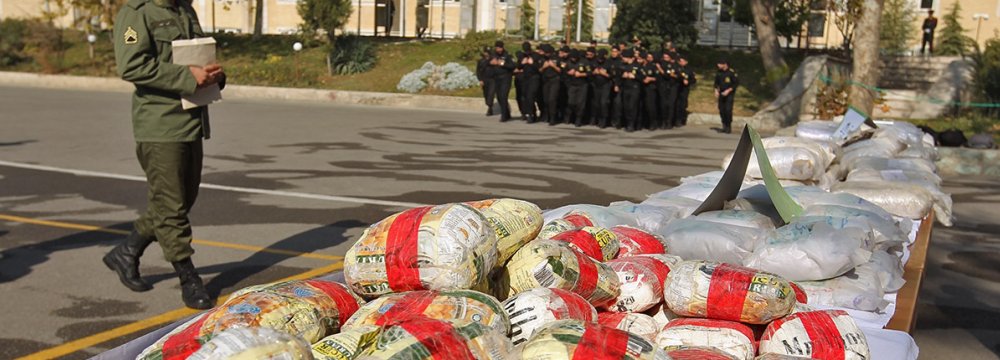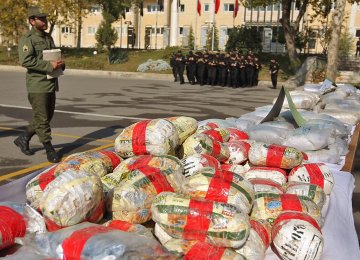Drug seizures by the Law Enforcement Forces increased by 15% in the last fiscal year (ended March 20), compared with the previous year (2015-2016) when the seizures registered a 11% increase over the preceding year, says Colonel Mohammad Masoud Zahedian, anti-narcotics police chief.
“Last year, 631 tons of drugs were seized by the police, signaling a 15% jump in overall seizures vis-à-vis the corresponding period last year,” he told a press briefing at the weekend in Tehran, IRNA reported.
One million recovering addicts were educated and informed about preventive strategies and how to handle situations that expose them to drugs. Additionally, 1.3 million educational packages (including brochures and CDs) were distributed in city outskirts and among vulnerable populations in unofficial settlements.
According to official figures, there are 1.4 million addicts (10% are women) in the country, of which 30-40% are under the coverage of rehabilitation centers.
“The fight against drugs should become a societal move,” Zahedian stressed.
The Iranian Drug Control Headquarters (IDCH), the national organization in charge of coordinating efforts by the various agencies involved in the fight against production, distribution and trafficking of the illicit drugs, has been facing increasing challenges in the unending war against narcotics.
It says 16% of the armed conflicts with drug traffickers last year occurred at the eastern borders.
Tehran has often urged the big powers and the UN to rethink their anti-drug policy and extend meaningful assistance against the drug mafia operating in and from the joint borders with the world’s opium capital (Afghanistan) and Pakistan.
Severing the link between drug users and smugglers is a high priority in the fight against the drug scourge, says Parviz Afshar, deputy head of IDCH.
Pointing to the drug hauls in the first two months of the current fiscal, Afshar said at a press briefing last week that the seizures had jumped by about 20% compared to last year.
Five-Year-Plan
“The next five-year economic, social and cultural development plan (2017-22) targets a 25% reduction in substance abuse. We are prepared to achieve the goal,” he said.
The IDCH has been pushing for non-governmental organizations working in the area of drug addiction to become more active and involved in curbing and controlling addiction and trafficking.
Around 3,000 such NGOs are registered in the country of which 2,300 are assessed “as active and competent,” according to the IDCH.
Each NGO is categorized at three levels according to infrastructure, number of members, type and range of activities. They also have the opportunity to upgrade after attending special educational workshops held by the IDCH.
Also calling for community-based approach in the fight against narcotics, Minister Abdolreza Rahmani-Fazli underlined last year that every individual should participate in preventing and combating drug abuse, rather than just leaving it to the government and anti-drug police.
The rate of success for drug addiction treatment in the world stands at 35-40%, but in Iran it is 15-20%. The success rate depends on the rate of relapse post-recovery.
Comprehensive Fight
The policy of fighting the drug problem is comprehensive and hinges on five major pillars including curbing supply, primary prevention, treatment, harm reduction, and public participation.
Iran shares a 900-km porous border with Afghanistan and is used as the main conduit for smuggling drugs from the neighboring war-torn country to the crime syndicates and drug kingpins in Europe. Despite this, Iran is at the frontline of the fight against the scourge.
Drug trafficking is the most common crime in Iran. Nearly 40% of prisoners have been convicted and are serving terms on drug-related charges.
Last year more than 50% of convictions, 60% of thefts, and 50% of divorces in the country were related to drugs and substance abuse, Rahmani-Fazli lamented.
Iran has spent more than $700 million to seal the borders and prevent the transit of narcotics destined for European, Arab and Central Asian countries. The war on the drugs originating from Afghanistan has claimed the lives of over the past three decades.
About 20%-30% of the drugs that enter the country are found and seized by the police annually.






Add new comment
Read our comment policy before posting your viewpoints